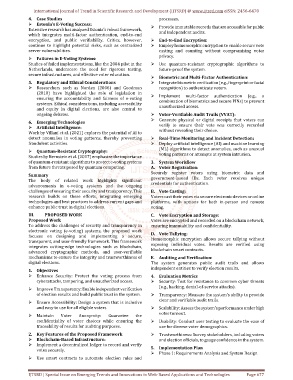Page 687 - Emerging Trends and Innovations in Web-Based Applications and Technologies
P. 687
International Journal of Trend in Scientific Research and Development (IJTSRD) @ www.ijtsrd.com eISSN: 2456-6470
4. Case Studies processes.
Estonia’s E-Voting Success: Provide immutable records that are accessible for public
Extensive research has analyzed Estonia’s robust framework, and independent audits.
which integrates multi-factor authentication, end-to-end
encryption, and public verifiability. Critics, however, End-to-End Encryption:
continue to highlight potential risks, such as centralized Employ homomorphic encryption to enable secure vote
server vulnerabilities. casting and counting without compromising voter
privacy.
Failures in E-Voting Systems:
Studies of failed implementations, like the 2004 pilot in the Use quantum-resistant cryptographic algorithms to
Netherlands, underscore the need for rigorous testing, future-proof the system.
secure infrastructures, and effective voter education.
Biometric and Multi-Factor Authentication:
5. Regulatory and Ethical Considerations Integrate biometric verification (e.g., fingerprint or facial
Researchers such as Norden (2006) and Goodman recognition) to authenticate voters.
(2010) have highlighted the role of legislation in
ensuring the accountability and fairness of e-voting Implement multi-factor authentication (e.g., a
combination of biometrics and secure PINs) to prevent
systems. Ethical considerations, including accessibility
unauthorized access.
and equity in digital elections, are also central to
ongoing debates. Voter-Verifiable Audit Trails (VVAT):
Generate physical or digital receipts that voters can
6. Emerging Technologies
Artificial Intelligence: verify to ensure their vote was correctly recorded
Work by Villani et al. (2021) explores the potential of AI to without revealing their choice.
detect anomalies in voting patterns, thereby preventing Real-Time Monitoring and Incident Detection:
fraudulent activities. Deploy artificial intelligence (AI) and machine learning
(ML) algorithms to detect anomalies, such as unusual
Quantum-Resistant Cryptography:
voting patterns or attempts at system intrusion.
Studies by Bernstein et al. (2017) emphasize the importance
of quantum-resistant algorithms to protect e-voting systems 3. System Workflow
from future threats posed by quantum computing. A. Voter Registration:
Securely register voters using biometric data and
Summary
government-issued IDs. Each voter receives unique
The body of related work highlights significant
credentials for authentication.
advancements in e-voting systems and the ongoing
challenges of ensuring their security and transparency. This B. Vote Casting:
research builds on these efforts, integrating emerging Voters cast their votes via secure electronic devices or online
technologies and best practices to address current gaps and platforms, with options for both in-person and remote
enhance public trust in digital elections. voting.
III. PROPOSED WORK C. Vote Encryption and Storage:
Proposed Work Votes are encrypted and recorded on a blockchain network,
To address the challenges of security and transparency in ensuring immutability and confidentiality.
electronic voting (e-voting) systems, the proposed work
D. Vote Tallying:
focuses on designing and implementing a secure,
Homomorphic encryption allows secure tallying without
transparent, and user-friendly framework. This framework
integrates cutting-edge technologies such as blockchain, exposing individual votes. Results are verified using
blockchain smart contracts.
advanced cryptographic methods, and user-verifiable
mechanisms to ensure the integrity and trustworthiness of E. Auditing and Verification:
digital elections. The system generates public audit trails and allows
independent entities to verify election results.
1. Objectives
Enhance Security: Protect the voting process from 4. Evaluation Metrics
cyberattacks, tampering, and unauthorized access. Security: Test for resistance to common cyber threats
(e.g., hacking, denial-of-service attacks).
Improve Transparency: Enable independent verification
of election results and build public trust in the system. Transparency: Measure the system’s ability to provide
clear and verifiable audit trails.
Ensure Accessibility: Design a system that is inclusive
and easy to use for all eligible voters. Scalability: Assess the system’s performance under high
voter turnout.
Maintain Voter Anonymity: Guarantee the
confidentiality of voter choices while ensuring the Usability: Conduct user testing to evaluate the ease of
traceability of results for auditing purposes. use for diverse voter demographics.
2. Key Features of the Proposed Framework Trustworthiness: Survey stakeholders, including voters
Blockchain-Based Infrastructure: and election officials, to gauge confidence in the system.
Implement a decentralized ledger to record and verify
votes securely. 5. Implementation Plan
Phase 1: Requirements Analysis and System Design
Use smart contracts to automate election rules and
IJTSRD | Special Issue on Emerging Trends and Innovations in Web-Based Applications and Technologies Page 677

